French Royal Armour as Reflected
in the Designs of Etienne Delaune
An article by Bruno Thomas
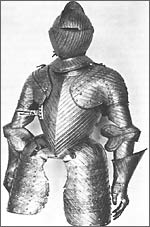
Fig. 1—Suit of armour engraved and gilded throughout in imitation of textile and embroidery, made for Charles IX in about 1570. (Paris, Musee de l'Armee)
|
 European armour, whether gothic, renaissance, manneristic or even baroque, was not just a rough, simple object for military use, a defensive arm with no other aim than the primary one of safeguarding the wearer's life and limb. Rather, though wrought and riveted instead of scissored and sewn, it represented in all its periods of brilliant presence in our civilization a species of iron integument created in accordance with those same laws and currents that governed the styles and evolutions of textile clothing—in a word, fashion. Moreover, weapons and their accessories, too—swords, daggers and firearms in their inexhaustible varieties over the centuries—were often chiseled, enameled, bejeweled, chased, carved, inlaid and otherwise more or less resplendently elaborated constituents of the male costume. But armour was much more than just glitter and vogue: it forms nothing less than a vital chapter in the history of European sculpture, a very special type of three-dimensional art—sculpture in hard iron—which the onlooker must experience and enjoy literally from all directions. A mobile and stylized layer conceived and constructed almost like an outward extension of the human body it covered, armour was first of all required to adapt itself to, and to obey with elegance and precision, its wearer's every movement, idealizing his shapes and measures, transforming his appearance according to the dictates of art and ingenuity; it was a work of art often as astonishingly refined and rich in its solution of spatial and dynamic problems as in its realization of ornament.
European armour, whether gothic, renaissance, manneristic or even baroque, was not just a rough, simple object for military use, a defensive arm with no other aim than the primary one of safeguarding the wearer's life and limb. Rather, though wrought and riveted instead of scissored and sewn, it represented in all its periods of brilliant presence in our civilization a species of iron integument created in accordance with those same laws and currents that governed the styles and evolutions of textile clothing—in a word, fashion. Moreover, weapons and their accessories, too—swords, daggers and firearms in their inexhaustible varieties over the centuries—were often chiseled, enameled, bejeweled, chased, carved, inlaid and otherwise more or less resplendently elaborated constituents of the male costume. But armour was much more than just glitter and vogue: it forms nothing less than a vital chapter in the history of European sculpture, a very special type of three-dimensional art—sculpture in hard iron—which the onlooker must experience and enjoy literally from all directions. A mobile and stylized layer conceived and constructed almost like an outward extension of the human body it covered, armour was first of all required to adapt itself to, and to obey with elegance and precision, its wearer's every movement, idealizing his shapes and measures, transforming his appearance according to the dictates of art and ingenuity; it was a work of art often as astonishingly refined and rich in its solution of spatial and dynamic problems as in its realization of ornament.
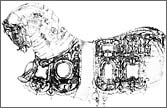
Fig. 2—Draft of an equestrian armour designed for Francis I in about 1540; in the style of Rosso Fiorentino, Fontainebleau school. (Munich, Staatliche Graphische Sammlung)
|
Smooth armour is pure shape. Its surface could be left in the white or be decorated in many different ways: by gilding, bluing or blackening, by etching, engraving or by gold and silver damascening, and—most exalted of all techniques—by embossing and chasing into bas-reliefs ranging in complexity from sparse ornamental motifs, sometimes enriched by single figures, to vast tableaux depicting complete, often agitated and amply populated scenes within rich borders; drawings and paintings by celebrated contemporary masters were not infrequently used as sources. Embossed relief was sometimes left plain and at other times enhanced by overetching or by engraving, or by gilding and silvering, or by over-painting with oil paint to imitate lacquer or enamel. The final results were the parade armours reserved for emperors, kings and princes, and for their regents and marshals and dignitaries of rank and riches. There were several centers of production throughout Europe. In Italy, Milan ranked highest, not only on a peninsular but also on a continental scale; Brescia was second. In Germany and Austria, Augsburg remained ever unsurpassed, followed by Innsbruck, Nuremberg, Landshut and Brunswick. In the Low Countries it was Antwerp and Brussels, in England, Greenwich. In France, too, a national school was active between about 1540 and 1630; but, whereas other schools have been explored and presented in works like Die deutsche Plattnerkunst (B. Thomas), L'Arte dell'Armatura in Italia (G. L. Boccia/E. Coelho), L'Arte Milanese dell'Armatura and Die Innsbrucker Plattnerkunst (B. Thomas/O. Gamber), Greenwich Armour and Armour in Spain (B. Thomas) and others, French armour, with its exquisite masterpieces conceived in very special taste, has never received the benefit of presentation in a comprehensive and representative volume. Only about a dozen publications exist, mostly monographs on single specimens and partly essays studying certain aspects. Moreover, owing to the total lack of pertinent documents in the archives and of positive identification of masters' marks and signatures, it has proven thus far impossible, in spite of all efforts, to locate the workshops of French armourers.
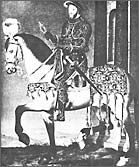
Fig. 3—Portrait by Jean or Francois Clouet, about 1540, of Francis I in an embossed armour which, like the equestrian complement, is of a true French style. (Florence, Uffizi Galleries)
|
Hence the present writer deems himself fortunate to have at least succeeded in establishing the part played by Etienne Delaune (1518/19-1583), medallist, designer, engraver and generally Chief Artist to the court of Henry II (r. 1547-59), as almost the sole designer of the decorations on King Henry's parade armours—although it must be pointed out that except for the one single case of a morion and buckler that belonged to Charles IX (r. 1560-74), now in the Louvre and executed after Delaune's drawings by the Parisian goldsmith Odilon Redon before 1572, no armourer's name has, in fact, been found for any other French arm or armour. If this seems astonishing, how much more so the fact that nowhere has there been preserved, not in France nor anywhere else, one single piece of armour of proved French origin made before the last years of the reign of Francis I, i.e. before about 1l540-45, nor a single object of military use nor a single pageant piece (with but the one exception of the sad remains in the Chartre Museum of an armour of King Charles VI [r. 1380-92], Italian work or perhaps French, now reduced to fragments, dating from about 1388-1400)! Therefore French armour before about 1540-45 can only be studied by means of contemporary iconographic sources depicting battles, tournaments, feasts and the like. In strange and dramatic contrast, the noble families of Italy, Austria and Germany carefully conserved personal arms and armour all through the centuries right down to our days. Why this should be so no one has ever really managed to explain, but it gives even greater urgency to the need for continuous researches so that perhaps one day we may come to know more about the character and development of the French armour proper. But we do know that the inspiration—at least as
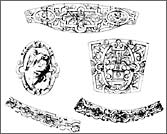
Fig. 4—Five drawings of components of a suit of man and horse armour, the ornamentation based on royal monograms and emblems, by Etienne Delaune, about 1555, in First Variant style. (Munich, Staatliche Graphische Sammlung)
|
far as the 16th century goes—derived from Italian models. In fact, all the 16th century French arts, major and minor, deriving from what is now called the Fontainebleau school, are strongly Italian-oriented, an all but indelible imprint that started when Francis I engaged Rosso Fiorentino (1494-1540) in 1530 (gallicised to le Roux, "the Redhead") and Francesco Primaticcio (1504-1570) in 1532 (le Primatice, roughly "the Early One", although the Italian-French sense can't be really translated) for the express purpose of bringing and teaching the Italian arts to France. Just as Francis I collected masterpieces by Leonardo and Raphael, by Titian and Cellini, so he and his son Henry II demanded and wore the masterpieces of armour created in Milan. A dozen specimens of these have survived in different collections, particularly in the Musee de l'Armee in Paris—works by Giovanni Paolo Negroli and his more famous cousin Iacopo Filippo. Perhaps the Italian armour "alla romana" (a style created by the Milanese armourers in the image of Roman antiquity to vest contemporary regents in the aura of Roman emperors) worn by Francis on the tapestry L'Unite de Etat in Fontainebleau really existed and was not just a symbolistic invention of the painter. His Lion Armour with its silver cross can be seen in the Musee de l'Armee. The casque with the Medusa, believed to have been his (now in the Metropolitan Museum of Art, New York), bears the date 1543 and the signature of Filippo Negroli. The Musee de 1'Armee possesses an exquisite armour of Henry II when dauphin, damascened in silver on blackened ground; the present writer attributes this, too, to Filippo Negroli. An Italian armour with scrolled foliage and the emblems of Henry II was illustrated by Filippo Orsi of Mantua in his book of drawings of 1554. An engraving by Nicolo della Casa dated 1547 represents the young king wearing an armour "alla romana."
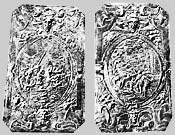
Fig. 5—Two plaques from horse armour made for H enry II after drawings by Etienne Delaune, 1556-59, in First Variant style. (New York, Co.O. Von Kienbusch Collection)
|
In addition to favoring the Italian school, however, both Francis I and his son encouraged and promoted the development of a truly French one, too—Henry far more even than his father. In 1549, two years after the Nicolo della Casa engraving, Jean Goujon drew Henry and his horse in armours decorated with repeated scrollwork which is no longer pure Italian but emergent French. As the century progressed, French collaborators and pupils of the Italian masters at Fontainbleau and in Paris—including the armourers—freed themselves, little by little but surely, from the powerful foreign domination; by about 1550-60 the body of the French armourers were working in a markedly French idiom —and a very fine one at that, destined to breed true, to flower and to influence the North and East of Europe via Antwerp and Augsburg, manifesting itself even in Sweden, in Saxony and in Poland. At first this new manner still hewed to Italian antecedents, but soon there appeared borderlines cut out to form semi-circles (or convex scallops), and an ornamentation consisting of interlaced bands characteristic of French mannerism; the technique of execution was acqua forte etching and gilding over the entire surface. One of Henry II's armours of about 1550, formerly in the Wartburg in Thuringia but missing since 1945, was covered with an etched copy of a drawing by Jacques I. DuCerceau, representing arabesques and figurative scenes enclosed by such interlaced bands; but DuCerceau still leaned heavily on the Fontainebleau school, and particularly on Rosso Fiorentino, for his inspiration in ornamental motifs. Three armours, also entirely gilded, belonging to Henry's three sons and successors (Francis II, r. 1559-60; Charles IX, r. 1560-74; and Henry III, r. 1547-89) and now in the Musee de l'Armee, are French works rendered very characteristic by their etched-iron imitations of painted paper, tapestry and embroidered textiles (Fig. 1). In short, French armour had its origins in italianate Fontainebleau, perceiving and transforming a la jrangaise the impulses and conceptions all'italiana imported from the South.
An extremely influential series of drawings in the manner of Rosso Fiorentino were found among the preparatory sketches for the wainscoting and a fireplace in Fontainebleau; they are part of an incomparable collection of 170 sheets in the Staatliche Graphische Sammlung (National Graphics Collection) in Munich, showing life-sized armour designs, all the parts of the armours being shown as entirely covered with the ornamentation that is to be transposed in bas-relief.1 Most of these 170 works, but not all, are by the hand of Etienne Delaune and, in fact, to understand them in proper perspective one must first consider the ornamental devices found on those among them done by Delaune's forerunners in Fontainebleau, such as the drawings for the wainscoting in the Gallery of Francis I executed between 1535 and 1540 by the Italian master Francesco da Carpi, or the drawing for the fireplace in the Queen's chamber done by Primaticcio himself. (Parenthetically, the present writer would like to seize the occasion to urge competent specialists in these spheres to help make a little order by analyzing and attributing these drawings to the most probable authors, Italian as well as French.) Of the many superb armour designs (e.g., Fig. 2), a few were realized in armours that are still extent or known to have existed until recently (e.g., a fine chaffron, until 1945 in the Musee de TArmee, is now lost). A project for a burgonet by an unknown master, in the present writer's view a Frenchman, is outstanding for its new assertion of independence from the impassioned, muscular, almost acrobatic Italian themes; similarly conspicuous is a drawing for a missal binding and for a dagger sheath. But the decisive step from Italicism to true Gallicism appears on two modest sheets of drafts for two gorget lames of the very armour worn by Francis I in a portrait painted by Jean or Francois Clouet shortly after 1540 (Fig. 3).
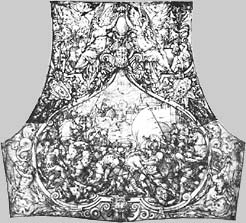
Fig. 6—Design for the backplate of the Julius-Ceasar-and-Pompei Armour by Etienna Delaune, about 1558-59 in Second Variant style. (H.M. Armouries in the Tower of London)
|
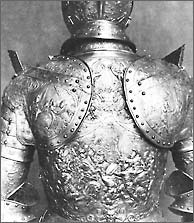 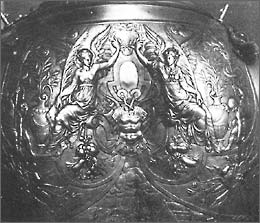
Fig. 7 & 7a—Overall and closeup views (one with the pauldrons removed) of the backplate made from the Deluane design in Fig. 6. (Paris, Louvre)
|
This armour, now lost without a trace, was the first example of a French parade armour; although still owning debts to Italian embossed antecedents, it was nevertheless a French creation with a strong and sure French personality. The kings from Henry II to Henry IV were to pride and preen themselves in the subsequent flowerings of this seedling, and Etienne Delaune was to be its nurturing husbandman.
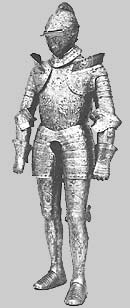
Fig. 8—Overall view of the entire armour shown in Figs. 7 and 7a.
|
All the remaining sheets consist of preparatory black-crayon bozzetti, pen-and-watercolor elaborations, and red-chalk copies of the latter, simply rendered, for execution in iron by the armourer-goldsmiths. Comparison with many undisputedly authentic drawings and engravings by Delaune confirms the attribution of about 146 of these 170 works to him. It is the impression of the present writer that this collection was, in fact, a part of Delaune's estate. Evidently he collected not only all the drawings of his Italian predecessors in Fontainebleau he could lay his hands on but of their French colleagues as well, adding also his own works. He and his son Jean seem to have lent a good many of these sheets to others, and finally to have bequeathed them all (also perhaps some now lost) to a pupil or companion in Antwerp or Augsburg: there would be no other way of explaining the fact that the goldsmith Eliseus Libaerts of Antwerp used and copied Delaune drawings when making embossed armours for King Eric XIV of Sweden between about 1560 and 1565, or that on the backs of five drawings by Delaune we find contemporary inscriptions in southern German, or that Delaune engravings were copied by an Augsburg artist in about 1575-80.
In short, careful studies of the Munich drawings inexorably reveal Etienne Delaune as the creator of truly French armour and pageant bucklers in the third quarter of the 16th century. Moreover, he arrived at three styles for embossed bas-relief that became recognizable "signatures": First Variant (Figs. 4 & 5): The framing dominates—it consists of renaissance interlacements formed of broad bands, masks and festoons, and central cartouches inhabited at most by one or two isolated figures.
Second Variant (Figs. 6, 7 & 7a): The framing is inhabited by more and more figures of symbolic and compositional importance, the border around the cartouche has become narrower, thinner; the cartouche shows whole scenes of battles, of ancient and modern history or of mythology; sometimes the cartouche is left without any enclosure. Third Variant (Fig. 10): Elegant scrollwork covers the entire surface; it contains a wealth of fabulous beasts and grotesques, creatures springing from a rich but still Italian-influenced fantasy.

Fig. 9—Buckler probably for Henry II made after a design by Etienne Delaune in Second Variant style. (Turin, Armeria Reale).
|
When was all this made? No doubt during the short reign of Henry II, i.e. between 1547 and 1559, while Delaune held, among other honors, the post of engraver to the royal mint, producing engravings for medals in 1556 for the commemoration of significant events in Henry's reign. No doubt it was he who was at the same time called upon to create sumptuous, spectacular pageant bucklers and parade armours to spread the renown of his master throughout the French and other realms. He also left many life-size drawings for five armours for man and horse ordered by Henry. The first set of six drawings is based
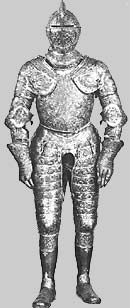
Fig. 10—Armour made after Delaune designs mixing motifs of cornucopias and Roman emperors, probably made for Henry II, c.1555. Second Variant style, Lombard-French execution. (New York, Metropolitan Museum of Art, ex ducal collections of Weimar).
|
on motifs of royal emblems: crown, fleur-de-lis, monogram H, crescent, and bow and arrows of Diana (Fig. 4), all very close in style to the fireplace ornamentations by Philibert Delorme executed between 1550 and 1556 for the ballroom at Fontainebleau; nothing has survived of the armour itself. These drawings are executed in the First Variant style. The second set, consisting of 71 drawings based on serpent motifs and also executed in First Variant style, is divided into twenty-five of man armour and forty-six of horse. The chaffron done from these existed until 1945 but is now lost, but three crupper plates survive in the Cluny Museum, Paris, and in the Kienbusch Collection, New York. Third comes a set based on the story of Julius Caesar and Pompey (Figs. 6, 7, 7a & 8), in Second Variant style, in which Henry II is identified with Caesar (his father had ordered himself to be represented as Vercingetorix!). The man's armour of this suite is preserved in the Louvre, the chaffron and saddle in Lyon. A fourth set is based on cornucopias (Fig. 10) and consists of twenty-one drawings in brown pen-and-watercolor done in Third Variant style, while a fifth set, also in Third Variant style, is based on a figure of a Roman emperor and consists of nineteen black-pen and gray-watercolor drawings; combinations of elements from these fourth and fifth sets were executed on Henry II's armour now in the Metropolitan Museum of Art, New York, i.e. the Roman-emperors theme for the breast- and back-plate, the cornucopia for all the other parts. Three designs for the Labours-of-Hercules Armour now in the Arms Collection of the Kunsthistorische Museum in Vienna have also been preserved. There are five Delaune drawings with scrollwork for the non-extant armour of an adolescent, probably the young Charles; its decoration is very similar to the Mars-and-Victory Armour, c. 1565-70, now in the Musee de l'Armee. Another drawing for a backplate can be identified by a portrait sketched in black crayon by Frangois Clouet in about 1570, in which Henry III is wearing his Lion Armour, the casque of which is in the Musee de l'Armee while one of its detached gorget plates rests in a private collection in the United States. Though no specific drawings have come to light, the spirit of Delaune was clearly the creative force behind several other armours of Henry III, now in Vienna and Dresden.
Let us briefly survey the embossed bucklers made after Delaune designs present in the Munich collection. Six bear the monogram and emblems of Henry II and illustrate events of his reign in embossed relief; most likely Henry had planned to hang these in the armoury projected for the Pavilion d'Armes at Fontainebleau; replicas without monograms exist, but it is not known for whom they were made. Delaune-designed bucklers executed in France (and also in Augsburg and Antwerp) are now present in collections all over the world, from New York to Skokloster (Sweden), from Leningrad to Turin, from Windsor Castle to Madrid. There are three shapes of Delaune bucklers: round, oval or pointed-oval, and fantasy shields with cutout contours. There exists also a series of bucklers with purely ornamental scrollwork.
Eienne Delaune's genius and taste reigned over the creations of royal parade armour in France until the death of Henry IV in 1610. His style was widely imitated in the North and the East of Europe; in France it underwent a revival in the 17th century through the designs of Jean Berain and his son, and again very forcefully in the 19th century through the imitations, the variations, the rhapsodies of embossed pseudo-Delaune work produced by the Lorraine master Antoine Vechte (1799-1868). The problems of Delaune's influence, in his own time and long after, continue to offer absorbing challenges to the researcher.
About the Author
Dr. Thomas served as director of one the most important repository of arms and armour in the world: the Waffensammlung, i.e. the Arms Collection of the Hapsburg Imperial Court, now a division of the Museum of Art History (Kunsthistorisches Museum) in Vienna. He studied art history, history, and languages. He began his career at the Waffensammlung in 1934; his principal aims—for the realization of which he has done research all over the world—have been the correlation of arms and armour history with generic art history, the development of refined methods of historical research, the installation at the Kunsthistorische Museum of effective and scientific restoration laboratories, and the reorganization and display of the entire Hapsburg collection in correct chronological order. He is the author of about two hundred publications in monograph and book form.
Notes
1. For a complete episode treatment of the Munich drawings, see B. Thomas, Die Miinchner Haniischvorzeich-nungen, in the Jahrbuch der Kunsthistorischen Samm-lungen in Wien, Vol. 55 (1959). Vol. 56 (1960). Vol. 58 (1962) and Vol. 61 (1965). Up to the moment of this writing, i.e. October 1973. these Yearbooks have been published only in German.
Acknowledgements
This article has been republished with permission by its original copyright holders.
|
|

